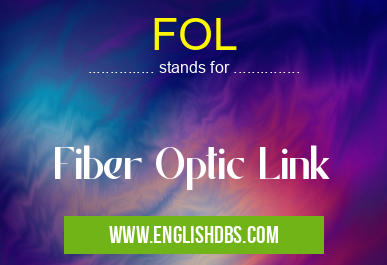What does FOL mean in NETWORKING
Fiber Optic Link (FOL) is a high-speed networking technology that uses optical fiber cable to transmit data. It is commonly used for long-distance communication and for connecting multiple networks together. FOL utilizes light waves instead of electricity, which allows for speeds up to 100 times faster than traditional copper cabling and far less susceptibility to electromagnetic interference.

FOL meaning in Networking in Computing
FOL mostly used in an acronym Networking in Category Computing that means Fiber Optic Link
Shorthand: FOL,
Full Form: Fiber Optic Link
For more information of "Fiber Optic Link", see the section below.
» Computing » Networking
Advantages
FOL has several advantages over copper cabling, namely speed, distance and reliability. Its ability to transmit data in both directions at once makes it much faster than copper cabling, making it ideal for high-bandwidth applications such as video streaming or voice over IP (VoIP). Its low attenuation also enables FOL networks to run much farther distances than traditional copper networks without needing signal boosters along the way. Because it is not affected by electromagnetic interference, FOL networks are more reliable and secure than their copper counterparts.
Essential Questions and Answers on Fiber Optic Link in "COMPUTING»NETWORKING"
What is a fiber optic link?
Fiber optic link is a type of communication system in which information is transferred using light signals through fiber optics cables. The light signals are generated by lasers or LEDs and are transmitted as pulses over the fiber, allowing for higher bandwidth and faster data transfer than traditional methods.
What advantages do fiber optics offer?
Fiber optics offer several advantages compared to traditional communication methods. These include higher bandwidth, faster data transfer speeds, greater reliability, longer transmission distances with less signal degradation, and more secure data transmission due to the immunity of the optical fibers to electromagnetic interference.
What materials are used in fiber optic links?
Fiber optic cables typically consist of a central core made of glass or plastic surrounded by layers of cladding, protective coating, and an outer sheath. The core transmits the light signals, while the cladding prevents them from escaping the cable. The protective coating helps prevent external damage to the cable, while the outer sheath provides mechanical protection.
Can fiber optics be used for voice and video applications?
Yes, fiber optics can be used for transmitting voice and video applications such as VoIP (Voice over IP) and IPTV (Internet Protocol Television). The increased bandwidth available with fiber optic links lend themselves particularly well to these types of applications.
How expensive is ditching copper cabling for fibre infrastructure?
Costs associated with switching from copper cabling to fibre infrastructure vary depending on factors such as location and complexity of your network setup. In general however, large-scale upgrades can be expensive but will generate long-term cost savings as well as providing additional benefits such as higher speeds and reliability.
Is there anything else I should consider before installing a fibre optic link?
Before setting up a fibre optic link you should consider factors such as whether there is existing fibre infrastructure present at your location or whether new cabling needs to be installed; proximity to telecoms services; local regulations; environmental factors; security requirements; cost considerations etc...
Are there any possible problems associated with Fibre Optic Links?
As with any type of communication system there are potential drawbacks associated with Fiber Optic Links such as issues related to transmission distance due to signal attenuation, susceptibility to physical damage caused by temperature variations or excess strain on cables during installation etc... However these problems can usually be avoided if proper implementation procedures are followed.
How many strands do most fibre optic links have?
Most Fibre Optic Links use single-mode cables consisting of either 8 or 12 individual strands that allow multiple channels on a single line for carrying high volumes of digital information simultaneously.
Final Words:
Fiber Optic Link (FOL) is a highly advanced networking technology that offers many advantages over traditional copper cabling, including higher speeds, greater transmission distances and increased reliability. As networks become more complex, FOL will become increasingly necessary in order to achieve the connectivity desired by businesses and consumers alike.
FOL also stands for: |
|
| All stands for FOL |
